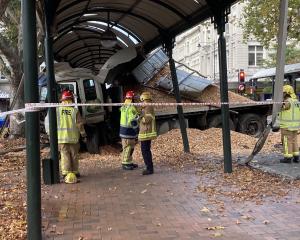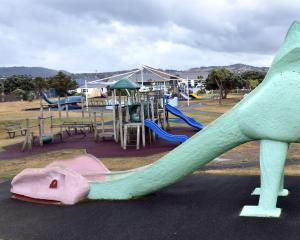Every time you walk into the Allied Press building is a moment to pause and reflect on the cost of war.

To your right is mounted the Roll of Honour for Otago Daily Times and Otago Witness staff who fought in the Great War.
In front is a similar plaque acknowledging Evening Star staff who served in the war.
Eleven of those men were killed in World War 1 — mechanics, compositors, machinists, reporters.
The modern day Otago Daily Times and Star staff are a tight-knit team of professionals, many of whom have worked together for decades.
The loss of just one of those people would send shockwaves through the building. Then, as now, newspapers diligently reported the deaths of New Zealanders.
Looking at those names, you imagine the professionalism required when news filtered back to Dunedin from Gallipoli, France or Belgium that someone who worked with you had died, to report on someone who was much more than another name.
Workplaces the city over shared the experience of loss — Allied Press is one of many to have its roll of honour still proudly on display.
A century on they are names perhaps barely glanced at, but they were:

 Fred Sinclair
FRED GEORGE SINCLAIR
Fred Sinclair
FRED GEORGE SINCLAIR


Fred Sinclair (23) was one of the first ODT staff members to volunteer in 1914.
He lived in Russell St, and worked at the newspaper as a linotype operator before joining the New Zealand Field Artillery, with which he served in Egypt, Gallipoli and France.
Gunner Sinclair’s military file suggests he got through the first three years of the war with little drama, but by 1918 he had transferred from a headquarters position as a trumpeter to serving as a gunner.
On January 9, 1918, with the artillery positioned near Ypres, Gnr Sinclair’s luck ran out. The regimental history records: "Hostile shelling was responsible for a number of casualties at gun positions, one unlucky shot on the night of the 9th January penetrating a dug-out in the 3rd Battery and killing all five occupants."
Gnr Sinclair was with "B Battery" and was one of those unlucky casualties.
Wounded in the chest and taken to a Canadian casualty clearing station, a note in brackets at the bottom of his file records: "dead on admission".
Fred Sinclair is buried in Lijssenthoek Military Cemetery, Poperinge, Belgium.
JOHN STEELE
A mechanic at the ODT, 28-year-old John Steele’s death at Gallipoli took a long time to be confirmed — a Board of Inquiry convened in March 1916 determined he was killed in the Dardenelles on August 15.
Steele, a private in the Otago Infantry Battalion, was an early volunteer — he attested on October 8, 1914, listing his address as the Leviathan Hotel.
Although Pte Steele’s death date was recorded as being August 15, 1915, that may have been a convenient fiction.
The battle for Chunuk Bair, in which the Otagos played a leading role, took place in the preceding days and it cut a swathe through the regiment.
With 17 officers and 300 other ranks listed as casualties, in the ensuing confusion the whereabouts of Pte Steele was one of many mysteries.
His military file suggests the army initially believed he had been wounded and shipped to England, before deciding he had in fact been killed.
His mother in Ponsonby posted a notice in the New Zealand Herald which placed her son’s death on August 7 or 8 — the Otagos relieved the Wellingtons in the forward trenches on Chunuk Bair on August 8, and soon after came under heavy attack.
However, a Herald brief around the same time suggests John Steele had not been seen since landing at Suvla.
John Steele does not appear to have a marked grave, but his name is on the Chunuk Bair memorial at Gallipoli.
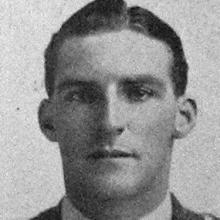 Archibald Henderson
ARCHIBALD GORDON HENDERSON
Archibald Henderson
ARCHIBALD GORDON HENDERSON

Archie Henderson (25) very nearly made it to the end of the war — he was killed by an accidental bomb blast on September 8, 1918.
While he listed his occupation as gold-miner when he attested, he held two positions in the ODT office, and was working there when he enlisted in the Otago Regiment as a private.
The former High St School pupil’s rise through the ranks was stellar: by the end of the Gallipoli campaign he was a sergeant and was awarded the Distinguished Conduct Medal in 1916.
His ascent continued as the war progressed: he was made an officer in France, and by September 1918 was a captain in the Entrenching battalion.
After all the dangers Capt Henderson faced, his death was a wretched accident.
While waiting with two colleagues for a wagon to arrive, they went for a walk and stumbled across a pile of loose explosives, one of which rolled and blew up, leaving Capt Henderson with unsurvivable injuries. His military file notes it may have been a booby trap, or someone may have kicked an unexploded bomb and unwittingly caused the explosion: "no blame attributable to anyone".
Archibald Henderson is buried in Grevillers British Cemetery, Pas-de-Calais, France.
WILLIAM PETER NELSON
The fate of ODT compositor William Nelson (32), like his colleague John Steele, required a Board of Inquiry to determine.
A private in the Otagos, he arrived in France in August 1916 and was soon thrown into the maelstrom which was the Battle of the Somme — from which he never emerged.
In the "Where soldier located" section of his military file is written: "No witnesses or guidance available. He was with his company when they attacked 27 September, 1916."
The pay owed Pte Nelson — a mere £1 4s 4d — was bequeathed to his mother, back home in Arthur St.
William Nelson’s name is engraved on the Caterpillar Valley Memorial.
 Ernest Barry
ERNEST WILLIAM BARRY
Ernest Barry
ERNEST WILLIAM BARRY

Private Ernest Barry (21) of Stuart St, was a printer’s apprentice at the ODT, and another who fell just before the war ended.
Pte Barry was shipped overseas late in 1917 — finally old enough, having been refused enlistment several times before due to his age.
However, he fell ill almost immediately and spent several months recuperating in England.
Pte Barry finally joined his fellow Otago Regiment soldiers in the field in late September, but just 13 days later he was killed in action in France, in the second Battle of Le Cateau.
He was one of 145 Otagos killed and wounded that day — in return, they had captured over 100 prisoners, a field gun, and 8 machine-guns.
Ernest Barry is buried in Marcoing British Cemetery, Nord, France.
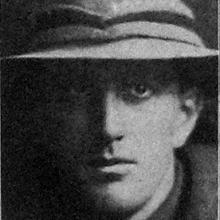 Bertie Cowie
BERTIE SHIEL COWIE
Bertie Cowie
BERTIE SHIEL COWIE

Corporal Bertie Cowie (23) was a reporter at the Evening Star.
Reading between the lines, he had leadership potential but was reluctant to take charge: after enlisting as a private in 1916, he was promoted to sergeant in 1917, but reduced to the ranks at his own request.
Cpl Cowie, who lived in Brown St, was a former Territorial and would have enlisted in the Otago Infantry Regiment sooner but for a bout of appendicitis.
That kept him out of Gallipoli but did not spare him from Passchendaele.
Quite when, where and how Cpl Shiel sustained his fatal injuries is not clear in his army file: "Died of wounds received in action October 5, 1917, in the field, France or Belgium."
His death was a second tragedy for the Cowies: Bertie’s elder brother Andrew died in 1916 fighting with the Australian army. Cpl Cowie’s Otago Witness obituary noted: "Dunedin reporters will sincerely mourn the death of Corporal Cowie, for he was a good comrade and gave promise of rising in his profession."
That edition saw rank trump newsworthiness: the obituary directly below noted the death of former All Black captain Dave Gallaher, who, as a private, followed behind Corp Cowie.Bertie Shiels is buried in Brandhoek New Military Cemetery No 3, Ieper, Belgium.
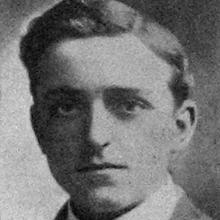 Donald Harper
DONALD MICKLEFIELD HARPER
Donald Harper
DONALD MICKLEFIELD HARPER

Donald Harper’s position at the Evening Star was "waiter" — which suggests slightly more genteel surrounds than we work in today.
Australian born, Andersons Bay resident Donald Harper’s paperwork notes two birth dates: his military file says 1889, his attestation form says 1893, with his "apparent age" being 20.
However, his death notice in The Star said he was just 18 ... two years under the legal age to enlist.
Sadly, Private Harper’s youthful enthusiasm was to be his undoing — his war lasted a matter of days.
The Otago Infantry Battalion landed on Gallipoli on April 25, and by June 5 Pte Harper was dead from gunshot wounds to the chest and head, suffered on an unnamed day at Monash Gully — a position the Otagos attacked on May 2.
Donald Harper is buried in Shrapnel Valley Cemetery, Anzac, Turkey.
 Alex McLauchlan
ALEXANDER ROBERTSON MCLAUCHLAN
Alex McLauchlan
ALEXANDER ROBERTSON MCLAUCHLAN

He was just 23, but Private Alex McLauchlan was well-travelled.
A Forbury School old boy, his journalism career began at the Evening Star, and he also spent two years on the "literary staff" at the Timaru Herald.
When war broke out in 1914 he was a reporter on the Gisborne Times, but enlisted almost immediately: his attestation form is dated August 18, 1914.
Pte McLauchlan sailed to Egypt with the Wellington Infantry and served at Gallipoli.
His military file offers no details after that, other than "Killed in Action 8/8/15" — family legend has it that he was hit by a sniper bullet and died of his wounds.
Had he survived, Pte McLauchlan would have had the biggest story of his life to tell: August 8 was the day when the Wellingtons stormed Chunuk Bair.
The 760-strong Wellington Battalion reached the summit just before dawn, and held it throughout the day.By the evening, when they were relieved, only 70 men were still standing.
Alexander McLauchlan’s body was seemingly not recovered: no war grave is recorded, but his name is on the Chunuk Bair Memorial.
SAMUEL AIMERS MACKAY
Samuel Aimers Mackay (42) was born to the paper trade: his father owned the Bruce Herald.
After a stint at the Alexandra Herald he joined the Evening Star as a linotype operator in 1906.
He left for Wellington in 1914, and Rifleman Mackay enlisted with reinforcements for the NZ Rifle Brigade in 1916.
After training in Egypt he was shipped to France, where he became one of many New Zealanders lost in the Battle of Messines.
His military file says he was killed in action and buried on June 7, 1917, but in the fog of war that grave site seems to have been lost.
When the army presented his grieving mother with her son’s medals and service plaque, the military file offers a small glimpse of personal grief: they were handed to Rifleman Mackay’s brother-in-law "as he was of opinion receipt of medals by mother would greatly affect her".
Samuel Mackay’s name is engraved on the Messines Ridge (New Zealand) Memorial, Messines Ridge British Cemetery, Belgium.
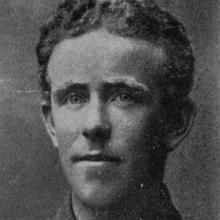 Walter Russell
WALTER RUSSELL
Walter Russell
WALTER RUSSELL

Walter Russell (22) was a salesman who worked for the Evening Star for two years before joining Dawsons Ltd — a jeweller’s and optician’s firm today known as Stewart Dawsons.
War soon put a stop to his new career, and early in 1915 he enlisted in the Otago Infantry Regiment.
Raised in Green Island, Private Russell evidently showed promise, moved to the base depot and became a lance corporal then a corporal.
By May 1916, he returned to the ranks and reverted to being a private — a move which seems voluntary as his conduct sheet had no blemishes on it.
It was a fateful decision, as a month later, on June 23, he was killed in action at Armentieres — an outpost in the Battle of the Somme.
The file reveals nothing of the circumstances, but the Official History notes Russell’s battalion was relieved from the front on June 21.
However, that did not mean it was in a place of safety: shelling continued, as did patrols, and one or the other may have claimed Pte Russell’s life.
Walter Russell is buried in Cite Bonjean Military Cemetery, Armentieres, France.
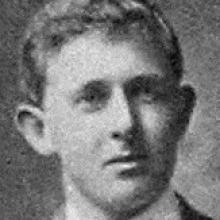 William Downing
WILLIAM GIBSON DOWNING
William Downing
WILLIAM GIBSON DOWNING

Corporal William Gibson Downing (23) so nearly survived Gallipoli.
The former Evening Star journalist was a reporter with the North Otago Times and living in Wharf St, Oamaru, when he enlisted in the Canterbury Mounted Rifles as a private.
Pte Downing knew first aid and he was drafted by the Field Ambulance, with which he served at Gallipoli.
In October 1915, he was promoted to corporal, and as December arrived the New Zealand troops began to make plans to evacuate Gallipoli.
However, Cpl Downing was to leave before his colleagues, after suffering a gunshot wound to the head on December 14 while helping wounded soldiers.
He was evacuated to Egypt, but died the day after he arrived in hospital.
The North Otago Times paid him full tribute: "He was keen and enterprising, gifted with a facile pen and although one of the humblest devotees of journalism, the unfolding of life opened up splendid prospects and his future seemed bright with high hopes and assured success."
William Downing is buried in the Alexandria Military and War Memorial Cemetery, Egypt.

